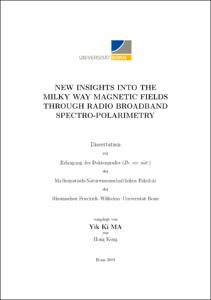New Insights into the Milky Way Magnetic Fields through Radio Broadband Spectro-polarimetry

New Insights into the Milky Way Magnetic Fields through Radio Broadband Spectro-polarimetry

| dc.contributor.advisor | Kramer, Michael | |
| dc.contributor.author | Ma, Yik Ki | |
| dc.date.accessioned | 2020-04-27T15:48:27Z | |
| dc.date.available | 2020-04-27T15:48:27Z | |
| dc.date.issued | 05.03.2020 | |
| dc.identifier.uri | https://hdl.handle.net/20.500.11811/8298 | |
| dc.description.abstract | Magnetic field is an essential ingredient of the interstellar medium of galaxies. In particular, an accurate characterisation of the magnetic field strength and structure of the Milky Way is crucial for complete understanding of many Galactic astrophysical processes. The Faraday rotation effect can be exploited to reveal the strength and direction of the magnetic field component parallel to the line of sight, which are imprinted in the rotation measure (RM) or Faraday depth (FD) values obtained from radio polarisation observations. In this thesis, I utilised the broadband spectro-polarimetric capability of the Karl G. Jansky Very Large Array (VLA) in L-band (1–2 GHz) to gain new insights into the magnetic fields of the Milky Way in two ways. Firstly, I investigated in the reliability of the NRAO VLA Sky Survey (NVSS) RM catalogue, which is the largest RM catalogue to date with 37,543 RM values north of declination of -40° (more than one RM per sq deg). The wide sky coverage combined with the high RM density have made the NVSS RM catalogue a potent data set for the study of Galactic magnetism, including modelling of the global Milky Way magnetic fields. A full understanding of systematics of the NVSS RM catalogue is therefore indispensable to our knowledge of the magnetism of the Milky Way. In particular, I have quantified the effects of nπ-ambiguity and off-axis instrumental polarisation in the NVSS RM catalogue. Secondly, I performed new radio observations for a direct study of the magnetic fields in the mid-plane of the Milky Way in the first Galactic quadrant. This specific region hosts a complex magnetic field structure being referred to as the large-scale field reversal, which has its details such as the field strength and the exact location poorly constrained owing to the lack of reliable RM values of background polarised extragalactic radio sources (EGSs). My new observations have led to a drastic increase in the number of lines of sight with probed magnetic fields by a factor of five, from which I have discovered new features in the Galactic magneto-ionic medium that were previously unnoticed. | en |
| dc.language.iso | eng | |
| dc.rights | In Copyright | |
| dc.rights.uri | http://rightsstatements.org/vocab/InC/1.0/ | |
| dc.subject.ddc | 520 Astronomie, Kartografie | |
| dc.subject.ddc | 530 Physik | |
| dc.title | New Insights into the Milky Way Magnetic Fields through Radio Broadband Spectro-polarimetry | |
| dc.type | Dissertation oder Habilitation | |
| dc.publisher.name | Universitäts- und Landesbibliothek Bonn | |
| dc.publisher.location | Bonn | |
| dc.rights.accessRights | openAccess | |
| dc.identifier.urn | https://nbn-resolving.org/urn:nbn:de:hbz:5-57732 | |
| ulbbn.pubtype | Erstveröffentlichung | |
| ulbbnediss.affiliation.name | Rheinische Friedrich-Wilhelms-Universität Bonn | |
| ulbbnediss.affiliation.location | Bonn | |
| ulbbnediss.thesis.level | Dissertation | |
| ulbbnediss.dissID | 5773 | |
| ulbbnediss.date.accepted | 16.12.2019 | |
| ulbbnediss.institute | Angegliederte Institute, verbundene wissenschaftliche Einrichtungen : Max-Planck-Institut für Radioastronomie (MPIfR) | |
| ulbbnediss.fakultaet | Mathematisch-Naturwissenschaftliche Fakultät | |
| dc.contributor.coReferee | Kroupa, Pavel |
Files in this item
This item appears in the following Collection(s)
-
E-Dissertationen (4460)




